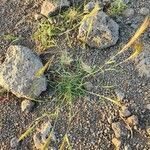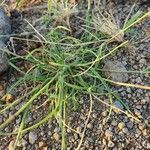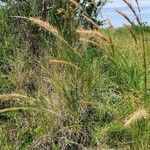Densely tufted perennial; culms 10–75 cm. high, glabrous.. Leaf-blades linear, 2–20 cm. long, folded or convolute; sheaths compressed, glabrous, the lower strongly keeled, the auricles bearded or not.. Panicle dense, bushy, spike-like, 3–20 cm. long, occasionally with 1 or 2 subspicate peduncled branches at the base.. Spikelets tinged with grey or purple; glumes unequal, lanceolate, scaberulous on the keel and sometimes also on the flanks, the lower 4–5 mm. long, the upper 6.5–10 mm. long, both with a short awn-point up to 2 mm. long; lemma terete, 4–5 mm. long, scabrid upwards; callus linear, ± 1 mm. long, narrowly truncate at the tip; column 2–4 mm. long, articulated just below the branching point of the awns; awns 12–30 mm. long.
Slender perennial or annual, up to 0.9 m tall, densely tufted. Leaves linear; ligule a fringe of hairs. Inflorescence a congested panicle, spike-like but often with 2 or 3 branches below. Spikelets densely packed in clusters at end of branches, 25-30 mm long (including awns), 1-flowered; glumes unequal; lemma 3-awned, column present, articulation between apex of column and base of awns.
Lemma 4-6 mm. long, tubular, scabrid, finely tuberculed, coarsely scabrid towards the apex; callus 1-1.5 mm. long, acute or acuminate, shortly barbate; column up to 4-6 mm. long, twisted, scabrous or scaberulous; awns subequal, up to 12-25(30) mm. long, scabrous, more or less divergent; articulation between the apex of the column and the base of the awns.
Glumes unequal, subhyaline; the inferior 4-8 mm. long, lanceolate, scabrous or scaberulous on the keel and often minutely scaberulous on margins towards the apex, often abruptly contracted at the apex, with a short awn, 1-4 mm. long; the superior 5-9 mm. long, narrower, scaberulous on the keel towards the apex, with a short awn 1-3 mm. long.
Panicle up to 20(25) cm. long, dense, contracted, spiciform, often interrupted towards the base, sometimes with 1 or 2 subspicate more or less spreading branches at the base; axis subterete, scaberulous; branches short, solitary, much divided from the base, usually appressed, slightly compressed, scaberulous.
Leaf-laminae up to 20 cm. long, linear, conduplicate to convolute, usually flat at the base, acuminate, fairly rigid and more or less curved, scabrous or hispidulous above, glabrous and smooth beneath, with the margins not thickened.
Leaf-sheaths slightly compressed, striate, glabrous or scaberulous upwards, the lower ones strongly keeled, with margins more or less overlapping at the base, the upper sometimes slightly keeled, tight.
Slender, perennial or annual to 90 cm, densely tufted. Leaves linear. Spikelets in a congested panicle, 25-30 mm long, lower glume awned, lemmas articulated above.
Culms erect or geniculate, simple or branched from the lower or upper nodes, rather wiry, nearly terete, glabrous, smooth, 3-4-noded; nodes glabrous, smooth.
Ligule a short-ciliolate rim; auricles barbate or glabrous; collar glabrous or minutely pubescent or somewhat barbate.
Perennial, up to 75(90) cm. high, densely caespitose.
Spikelets densely fascicled, purplish or greenish.
A grass.



